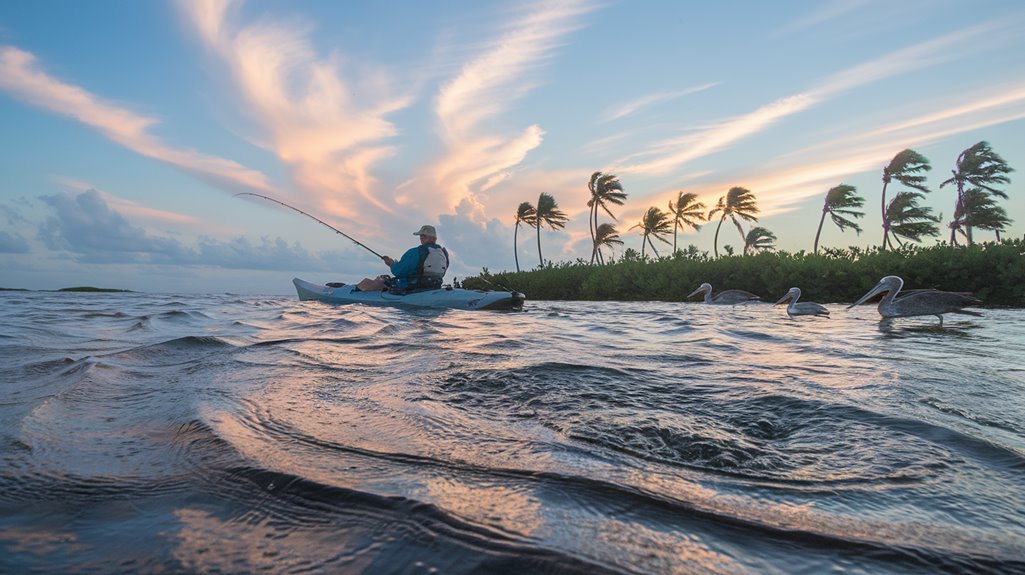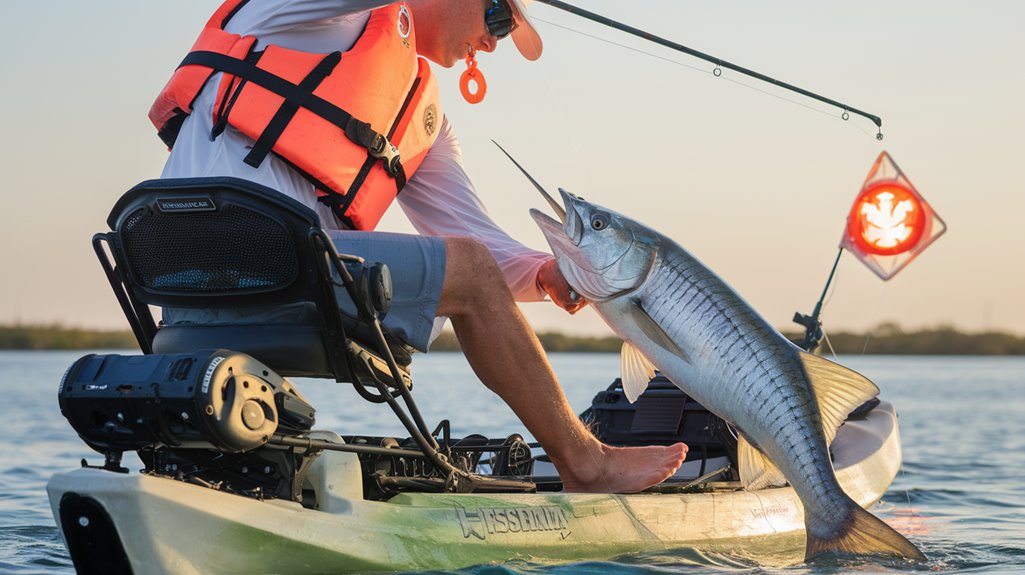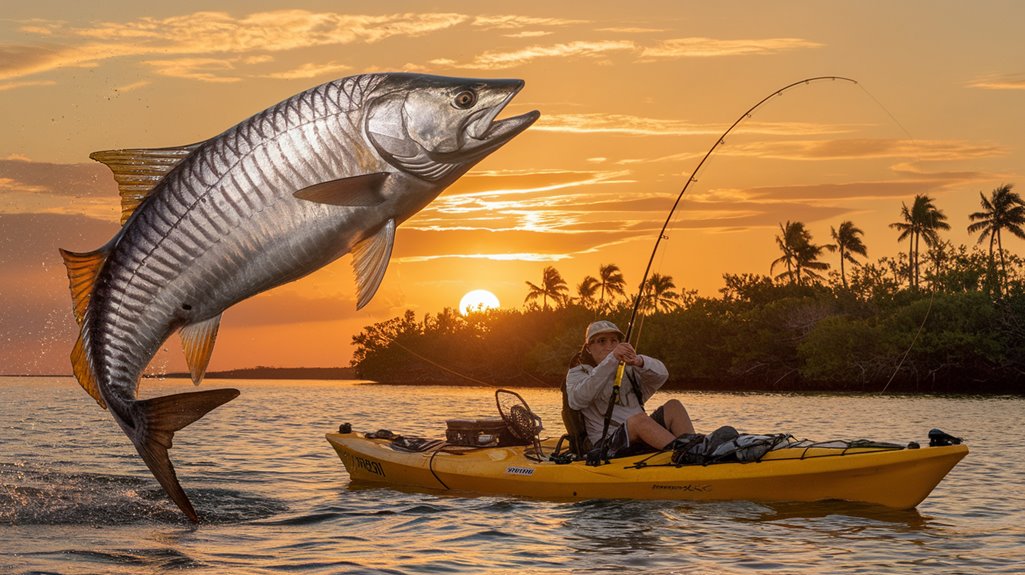If you're planning to tackle tarpon from a kayak or small boat, you'll need more than just basic fishing knowledge to succeed. The combination of these powerful gamefish and a compact vessel creates unique challenges that demand specific gear, techniques, and safety protocols. While many anglers stick to larger boats for tarpon fishing, you'll discover that a well-prepared small craft approach can offer distinct advantages – from accessing shallow backwaters to presenting baits with unmatched stealth.
Key Takeaways
- Use a 7-8 foot heavy-action spinning rod with soft tip and minimum 24-pound drag reel for optimal tarpon control.
- Keep live bait fresh and active in a Flow Troll bucket, hooking mullet behind dorsal fin and pogies near eyes.
- Position your kayak parallel to current near structure while minimizing noise and movement to avoid spooking fish.
- Maintain essential safety gear including life jackets, signaling devices, and first aid kit while informing others of trip details.
- Monitor weather conditions closely and stay hydrated, as Florida summer conditions can change rapidly during fishing trips.
Essential Gear and Equipment Setup
Three key pieces of equipment form the foundation of a successful tarpon fishing setup. You'll need a heavy-action spinning rod between 7-8 feet with a soft tip, paired with a 6000-8000 size spinning reel capable of at least 24 pounds of drag. For peak performance, spool your reel with 40-60 lb braided line connected to a 60-80 lb fluorocarbon leader.
Your essential gear should include a 5/0 extra strong circle hook to secure your bait effectively and improve hook-up rates. Don't forget to pack a thorough tackle box containing various lures and live bait rigs. Safety equipment is non-negotiable – always bring a life jacket and noisemaking device when targeting these powerful gamefish from your kayak.
Live Bait Selection and Handling
You'll need to start your day early to net fresh bait like mullet and pogies using a Sabiki rig, as these live offerings dramatically increase your chances of hooking tarpon. Keep your baitfish lively throughout the day by using a Flow Troll bucket, which provides constant water circulation and oxygen while you're on the move. When rigging live bait, position your hook behind the dorsal fin for mullet and ahead of the eye socket for pogies to maximize their swimming ability and longevity.
Catching Fresh Bait Daily
Success in tarpon fishing largely depends on your ability to catch and maintain fresh, live bait throughout your fishing day. Deploy a Sabiki rig to efficiently catch greenies, threadfins, mullet, and sardines – all prime live bait choices for catching tarpon. Store your caught bait in a Flow Troll bucket to keep them lively and energetic.
When rigging your live bait, hook mullet behind the dorsal fin, while pogies should be hooked ahead of the eye socket for ideal longevity. You'll want to regularly net fresh pogies and use the weaker ones as chum to maintain tarpon presence in your fishing area. Watch for rolling tarpon and predatory activity to strategically deploy your bait, maximizing your chances of a successful catch.
Proper Storage While Fishing
When fishing for tarpon, maintaining live bait significance requires proper storage equipment and consistent monitoring. During tarpon season, you'll need a well-aerated bait tank or flow troll bucket in your fishing kayak to keep mullet and pogies vigorous and ready for use.
Hook your live bait strategically – mullet behind the dorsal fin and pogies ahead of the eye socket – to maximize their swimming duration. You'll want to check your livewell regularly, removing any weakened or deceased bait that could reduce your fishing effectiveness. Since conditions can change rapidly on the water, it's essential to maintain a backup supply of fresh bait. Keep your cast net handy to replenish your bait stock when needed, ensuring you've got healthy, active bait throughout your tarpon fishing expedition.
Rigging Live Bait Effectively
Selecting appropriate live bait forms the foundation of successful tarpon fishing, with mullet and pogies serving as primary choices due to their natural appeal. You'll want to hook mullet behind the dorsal fin and pogies ahead of the eye socket for ideal swimming action.
| Bait Type | Rigging Method |
|---|---|
| Mullet | Behind dorsal fin |
| Pogies | Ahead of eye socket |
| Greenies | Standard hook placement |
For smaller baitfish like greenies, threadfins, and sardines, you can efficiently catch them using a Sabiki rig. Keep your live bait fresh in a Flow Troll bucket with proper aeration. To enhance your chances of success, try chumming with weak baitfish from your livewell to attract tarpon to your fishing zone.
Stealth Tactics and Positioning
Because tarpon possess heightened sensitivity to disturbance, mastering stealth tactics becomes essential for any serious kayak angler. You'll need to approach these wary fish with minimal noise and movement, keeping your profile low and your paddle strokes smooth and deliberate.
Position your kayak parallel to the current near structural elements like jetties or mangroves where tarpon typically feed. Let the current work to your advantage by drift fishing, staying alert for telltale signs of tarpon activity such as rolling or jumping. Once you've identified productive areas, carefully anchor your vessel to maintain your position without creating unnecessary disturbance. This strategic positioning allows you to present your bait effectively while remaining in the strike zone. Remember, successful kayak fishing for tarpon depends largely on your ability to remain undetected while maintaining ideal casting angles.
Reading Water and Weather Patterns

Successful tarpon fishing hinges on your ability to read and interpret water conditions and weather patterns effectively. You'll want to focus on green or blue water areas where bait pods concentrate, as these zones typically attract feeding tarpon. When you're scanning the water, watch for diving birds and jumping baitfish, which often signal tarpon activity beneath the surface.
Keep a close eye on tide movements, as tarpon become more active during tide changes when bait fish are forced to move with the current. You'll find the best fishing during early morning or late afternoon hours, particularly during stable weather patterns. Track local tide charts and avoid fishing during cold fronts or storms, as these conditions typically drive tarpon away from your fishing area.
Landing Techniques From Small Vessels
Landing a tarpon from a small vessel requires precise technique and careful attention to stability. You'll need to maintain a low stance in your kayak or boat to prevent tipping during the fight. Set the drag on your reel to 20-30% of your line's breaking strength to handle the tarpon's powerful runs and aerial displays.
Position your vessel parallel to the fish while using a long-handled landing net to maintain a safe distance during the capture. This parallel alignment reduces stress on your line and gives you better control throughout the landing process. Once you've secured the tarpon, work quickly to remove the hook and support the fish in the water. Minimizing time out of water is essential for ensuring a healthy release and maintaining the tarpon's health.
Safety Measures on the Water

You'll need essential safety gear before pursuing tarpon, including a Coast Guard-approved life jacket, noisemaking device, and white light for low visibility conditions. Prepare for emergencies by sharing your trip plan with someone onshore and maintaining constant awareness of weather conditions, particularly during Florida's unpredictable summer months. Keep emergency protocols straightforward: seek shelter immediately when storms approach, stay hydrated in the intense heat, and make certain all safety equipment remains readily accessible throughout your fishing expedition.
Essential Safety Equipment Checklist
Before heading out on your tarpon fishing adventure, proper safety equipment isn't just a legal requirement – it's essential for protecting everyone aboard. Your kayak must be equipped with U.S. Coast Guard-approved life jackets for each passenger, and you'll need reliable signaling devices for emergencies. Keep a well-stocked first aid kit within easy reach to handle any minor injuries that might occur on the water.
- A white light source for low-visibility conditions, meeting Florida boating regulations
- Emergency signaling devices, including updated flares and a marine radio or cell phone
- A noisemaking device such as a whistle or horn to signal for help
- Personal flotation devices that are Coast Guard-approved and properly fitted for each person
Weather And Emergency Protocols
Since weather conditions can shift dramatically during Florida's summer months, monitoring forecasts and establishing emergency protocols are essential aspects of tarpon fishing safety. You'll need to check the weather forecast before departure and stay alert for approaching thunderstorms that could create hazardous situations on the water.
Always wear your life jacket while fishing and make certain your vessel is equipped with required safety devices, including a noisemaking device and white light for low-visibility conditions. Before heading out, inform a friend or family member about your trip details and expected return time. They'll serve as your emergency contact and can alert authorities if you don't return as scheduled. Remember to bring plenty of water to stay hydrated, as heat exposure can impact your decision-making abilities while pursuing tarpon.
Frequently Asked Questions
Is Kayak Fishing Better Than Boat?
You'll find kayaks offer superior stealth, maneuverability, and intimate fishing experiences, while boats provide better stability, range, and comfort. Each has distinct advantages depending on your specific needs.
What Is the Best Setup for Tarpon Fishing?
You'll need an 8-foot heavy rod paired with a 6-8000 size spinning reel, spooled with 40-60 lb braid, 60-80 lb fluorocarbon leader, and strong circle hooks matched to bait.
What Is the Best Bait for Tarpon?
Purposefully pick live baits like ladyfish, ballyhoo, or needlefish for trophy tarpon. You'll find 10-inch Hogy Original Series soft baits effective, while juvenile tarpon readily strike Monster 3X or Yo-Zuri minnows.
What Is the Best Time of Day to Catch Tarpon?
You'll find the most success targeting tarpon during early morning hours before sunrise and late afternoon into evening. Fish during the last hour of incoming tide or first hour of outgoing tide.
Conclusion
With tarpon catch rates increasing by 40% when fishing from kayaks versus larger vessels, you'll find this approach both rewarding and effective. You're now equipped with essential techniques for small-vessel tarpon fishing, from gear selection to stealth positioning. Remember to maintain your safety protocols while pursuing these magnificent fish, and you'll maximize your chances of landing that trophy silver king in the challenging small-boat environment.

